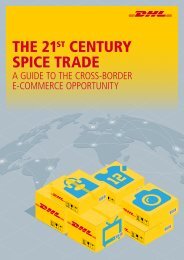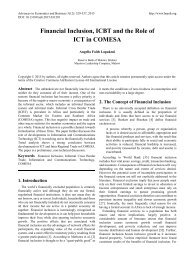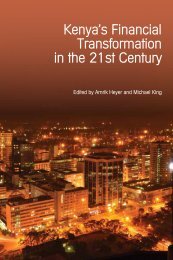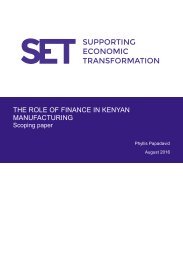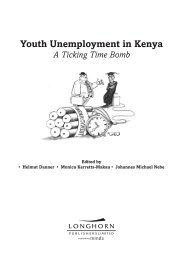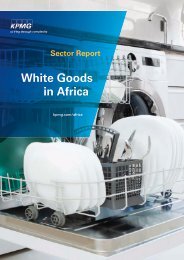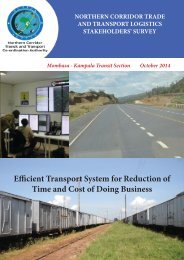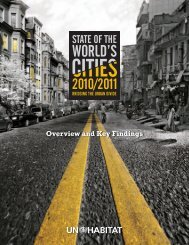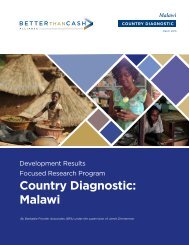FD
gvti301SEaf
gvti301SEaf
Create successful ePaper yourself
Turn your PDF publications into a flip-book with our unique Google optimized e-Paper software.
AFRICA<br />
rose from less than 2 percent before 2005 to about 15 percent<br />
in 2012. This has provided many African countries with<br />
a welcome new source of project financing. And increasingly,<br />
China is relying on Africa, which is a large source of engineering<br />
contracts to build roads and hydropower projects.<br />
China’s investment-heavy, export-oriented economic growth<br />
model made it a growing importer of commodities for most of<br />
this century. Chinese demand dramatically drove up the prices<br />
of metals, energy, and agricultural commodities to the benefit<br />
of sub-Saharan Africa’s many commodity exporters.<br />
But that has changed. Reduced investment in China has<br />
curbed its appetite for raw materials, resulting in a sharp<br />
swing in its trade balance with sub-Saharan Africa. Iron ore<br />
and oil prices, for example, have fallen by more than half<br />
from their recent peaks, and many other commodities have<br />
also suffered sharp declines. Futures markets suggest further<br />
declines in 2016 and little recovery before 2020.<br />
<strong>FD</strong>I is less cyclical and driven more by medium-term considerations<br />
than many other types of investment. But recent<br />
Chinese mine closures in sub-Saharan Africa (copper mines<br />
in Zambia, iron ore mines in South Africa, and the cancellation<br />
of an iron ore project in Cameroon, for example) suggest<br />
that returns on investment in the traditional commodity sectors<br />
are falling. In May 2015, China’s Ministry of Commerce<br />
estimated that the value of China’s <strong>FD</strong>I flows to Africa fell<br />
45.9 percent in the first quarter of 2015 compared with the<br />
same period in 2014. The number of approved projects has<br />
also been falling since 2013 (see chart).<br />
The immediate impact on commodity exporters has been<br />
severe. Oil exporters, in particular, are experiencing sharp<br />
declines in exports, putting pressure on foreign exchange<br />
reserves and exchange rates. Many commodity exporters<br />
also derive significant government revenue from natural<br />
resources and now face growing budget deficits and pressure<br />
to reduce spending. In Angola, for example, the fall in<br />
oil prices Chen, corrected wiped 4/11/20106 out about half of its revenue base, with a loss<br />
of more than 20 percent of GDP. Lower spending levels, in<br />
both the public and private sectors, have led to sharply lower<br />
growth for oil-exporting countries, now expected to average<br />
barely 2 percent in 2015–16, compared with an average of<br />
more than 7 percent in the preceding decade.<br />
Pulling back<br />
After steadily increasing direct investment in Africa since the<br />
start of the century, Chinese entities have sharply reduced<br />
the number of new projects since 2013.<br />
(number of projects)<br />
600<br />
500<br />
400<br />
300<br />
200<br />
100<br />
0<br />
2000 03 06 09 12 15<br />
Source: Chinese Ministry of Commerce.<br />
The spillovers from China are not limited to direct chan-<br />
nels such as lower export demand and global commodity price<br />
declines. There are also effects from one African economy on<br />
another. Slowdowns in large economies in sub-Saharan Africa,<br />
such as South Africa and Nigeria, affect smaller neighbors with<br />
Slowdowns in large economies<br />
in sub-Saharan Africa, such as<br />
South Africa and Nigeria, affect<br />
smaller neighbors.<br />
which they trade. Uganda, which is not a commodity exporter, is<br />
affected by the economic contraction in South Sudan, which had<br />
become an important destination for Uganda’s regional exports.<br />
Countries such as South Africa, Zambia, and the Democratic<br />
Republic of Congo are important exporters to China and also<br />
are large importers from other African countries.<br />
A silver lining<br />
But the dark clouds have at least two silver linings. China’s recent<br />
pledge to more than double the financing for Africa to<br />
$60 billion over the coming three years reflects both a strong<br />
commitment to the continent and the continued availability of<br />
ample financing for Chinese investors. Of course, it will require<br />
identifying new commercial opportunities, likely outside of the<br />
traditional natural resources sectors. But the recent surge in<br />
Chinese outward capital flows, especially from Chinese businesses,<br />
signals a continued appetite among Chinese investors to<br />
make investments and seek high returns outside their economy.<br />
Africa’s non-commodity-dependent frontier economies in east<br />
Africa, for example, could be attractive new growth markets.<br />
Moreover, global demographic trends provide an opportunity<br />
for sub-Saharan Africa to benefit from China’s new<br />
growth model (See “Surf the Demographic Wave,” in the<br />
March 2016 F&D). Bangladesh and Vietnam have already<br />
stepped into the global garment and textile value chains once<br />
dominated by China, which is moving up to other highervalue-added<br />
supply chains. In a supply chain, various stages<br />
of making a product, from extracting raw materials to final<br />
assembly, are performed in firms located in several countries.<br />
By 2035, the number of sub-Saharan Africans reaching<br />
working age (15–64) will exceed that of the rest of the<br />
world combined. If sub-Saharan Africa countries can reduce<br />
infrastructure bottlenecks, improve the business climate, and<br />
diversify their economies and increase their integration into<br />
global value chains over the coming decades, they will have<br />
a historic opportunity to decisively boost growth and reduce<br />
poverty on the continent. It will be up to the continent’s policymakers<br />
to seize this opportunity. ■<br />
Wenjie Chen is an Economist and Roger Nord is Deputy<br />
Director, both in the IMF’s African Department.<br />
Finance & Development June 2016 29



